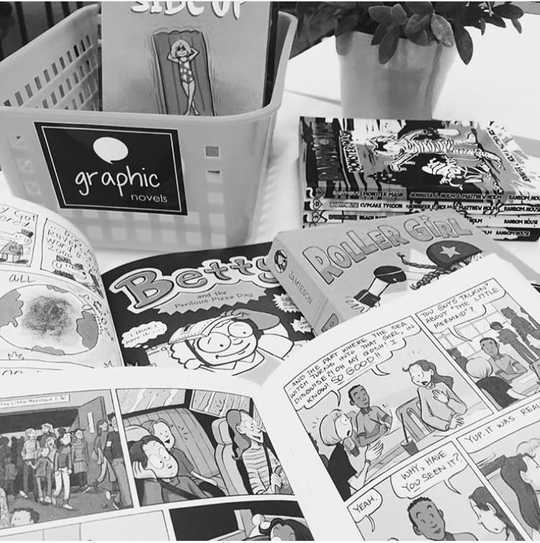|
Our classroom library is set up (mostly) by genre. There are other sections mixed throughout like classroom favorites, favorite authors, books in a series and format. Graphic Novels are considered a format. Quite simply, the definition of graphic novel is as follows: a novel in comic strip format. We want readers to understand that graphic novels have many different genres like other novels.
I thought it would be helpful to include some ways that graphic novels are collected and shared in our fourth grade classroom. It is my hope, that you also include a thoughtful collection of graphic novels in your elementary, middle and high school libraries. Here is my testimonial. I have many graphic novels in my classroom library for readers to choose from. We are constantly adding new titles, this is important: the constant curation. I still wish I could afford to buy a lot more, it's all a work in progress. A lot of my students are highly engaged with this format, and some students are only mildly interested. I do not like the term reluctant when describing readers, so I won't say that GNs are "top notch for reluctant readers." I will say that I have handed Kazu Kibuishi's Amulet series to a lot of kids and it almost always turns kids into active readers. Handing a child a Raina Telgemeier book usually has the same effect. It's like magic, they awaken from this possible reading slumber. What happens once that magic wears off and they're looking for the next great series or title? If you read graphic novels and seek them out, you will be waiting with another recommendation. This is great, but take the time to teach your kids how to find the next best thing on their own. We must be able to pull the scaffolds away and know that kids can do these things without us. Independence is the ultimate goal, and I tell my kids Mrs. Riedmiller will not always be waiting in the wings with a "try this next" suggestion. I know that you have to work hard to get to know kids to understand what is right to place into their hands. I know that just because a child doesn't want to follow along with a novel study complete with low level comprehension questions doesn't mean that they don't like to read, or that they are a "struggling or reluctant reader." Instead of labeling children, let's listen to them instead. Find out what they like and see if there is a graphic novel that would fall into that category. It took me quite sometime to discover all the sports graphic novels that Sports Illustrated Kids offers, and boy am I glad I did! This post will not include activites to do with students that have to do with graphic novels. My goal is to create life-long readers and I have to think about what adult readers do when they finish books. We do not often seek out to create a diorama or a book report. Therefore, I do not expect my students to take part in these types of activities either. Instead, we finish books, share what we have read and then make plans for what we will read next. Often times we are inspired to create something, and when that is the case, we make room to create and share. MAKING THE CASE FOR GRAPHIC NOVELS
BUILDING & CARING FOR A CORE COLLECTION
GRAPHIC NOVEL SERIES THAT 3-5 READERS LOVE
GRAPHIC NOVEL STAND ALONES THAT 3-5 READERS LOVE
These are MOST of the graphic novel titles that are included in my classroom library. I am constantly on the lookout for more to add to our selection and I know I have probably left some excellent titles off of my lists. If you have any suggestions that were not listed, please list them below.
4 Comments
Michele
1/4/2017 05:02:56 am
Great posts so far! Is there any way you can focus one of your posts on your daily reading schedule? I'm specifically wondering what your classes do when they first come in and what they're doing to respond to their reading. I know you don't like book reports, worksheets (neither do I), but there also has to be some accountability of their reading. Thanks so much!!
Reply
Kathleen
1/4/2017 05:21:49 pm
You are the kind of teacher I would love for my children to have- lifelong readers being developed for sure...
Reply
Debbie Welch
1/5/2017 10:36:41 am
Thank you for sharing this post. I am an elementary school principal in East Texas and I am building a library in my office. I have added several graphic novels to it during this year. I can't keep them on the shelf. Your list of books will be most helpful in adding to my graphic novel section. Thank you again.
Reply
Tara
1/8/2017 09:00:33 am
I've really liked both your posts so far. I love following you on Instagram. How did you get the gig for Scholastic where you reviewed books?
Reply
Your comment will be posted after it is approved.
Leave a Reply. |

 RSS Feed
RSS Feed
